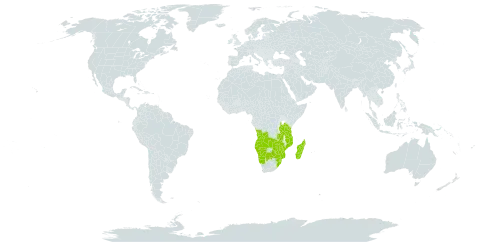Climbing herb; stem glabrous, smooth.. Leaf-blade broadly reniform-cordate in outline, obscurely toothed, shortly softly hairy or hispid-hairy, 36–54 mm. long, 52–70 mm. broad, palmately 3–5-lobed; lobes elliptic, rhombic or obovate, ± narrowed below; petiole shortly and sparsely hairy or glabrous, 18–26 mm. long.. Male flowers 3–12 in 1–5 mm. long racemes apical on 15–50 mm. long peduncles; pedicels 1.5–2 mm. long.. Female flowers often coaxillary with ♂, up to about 25 in sessile clusters or dense racemes; ovary ovoid, 3 mm. long, 1 mm. across.. Fruits 1–25 in sessile clusters or short dense racemes, on 1–3 mm. long stalks, ovoid or ovoid-conical, rounded above, not beaked, red, 9–11 mm. long, 5–8 mm. across.. Seeds pyriform, slightly rugose, margined, ± 4.5 × 3 × 2.5 mm.. Fig. 24/9, p. 140.
A pumpkin family herb. It is a creeper. Older stems have brown bark. The leaves are simple and alternate. The leaf stalk is 2-5 cm long. The leaf blade is oval and deeply divided into 5 lobes like fingers on a hand. The leaves are heart shaped at the base. The flowers are in a congested cluster. The male flowers have stalks and female flowers do not. The fruit is small and 8-9 mm long by 6 mm wide. They are in clusters and bright red. They contain about 6 seeds.
Leaf-lamina 2·2–7·5 × 2·7–11·0 cm., broadly ovate in outline, deeply cordate, minutely denticulate, shortly, finely and densely puberulous or scaberulous beneath, less densely so above and with age, deeply palmately 5-lobed, lobes broadly ovate to narrowly elliptic, obtuse to rounded, apiculate, the central largest.
Prostrate or scandent herb. Stems glabrous. Leaves palmately (3-)5-lobed, uniformly finely, rather densely puberulous or hispid above and beneath; petioles glabrous or minutely pubescent, not spiculate. Fruits 25-381 mm each cluster, glabrous, rounded. Flowers yellowish.
male flowers c. 6–25 in congested shortly racemiform pedunculate clusters; peduncle 0·4–6·9 cm. long; pedicels 1·5–4·5 mm. long. Receptacle-tube 1 mm. long; lobes 1 mm. long, lanceolate. Petals c. 1·5 mm. long.
Stems prostrate or scandent, smooth, sparsely spiculate, otherwise glabrous, when older softly woody with smooth brown bark, eventually becoming white-callosed and ridged.
Petiole 1·7–5·4 cm. long, sparsely shortly setulose, otherwise glabrous or sparsely moderately densely antrorsely puberulous.
Fruits 8–9 × 6–6·5 mm., clustered, sessile, shortly ellipsoid, rounded, erostrate, glabrous, bright red.
Female flowers sessile, in many-flowered congested fascicles, rhachis ± incrassate.
Seeds 3·5–4·5 × 2·4–2·8 × 1·6–2·3 mm., smooth or verruculose, nitid.
